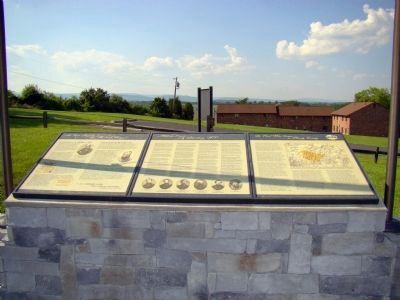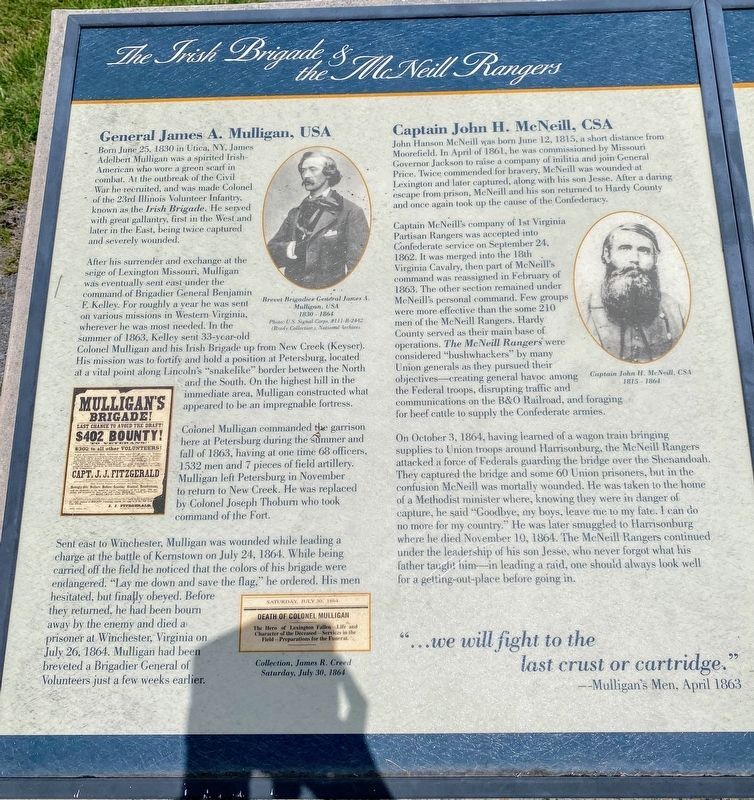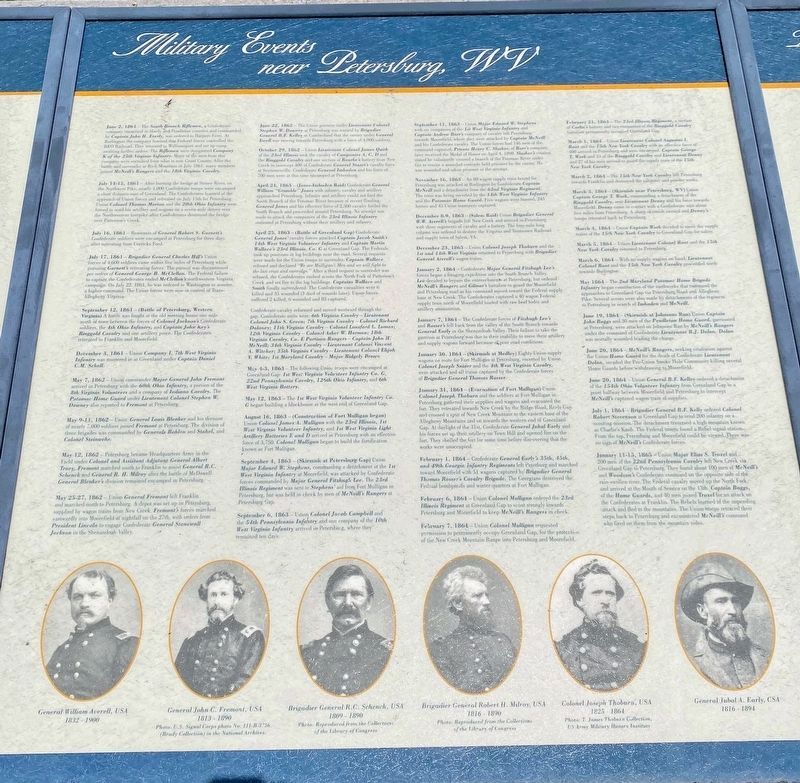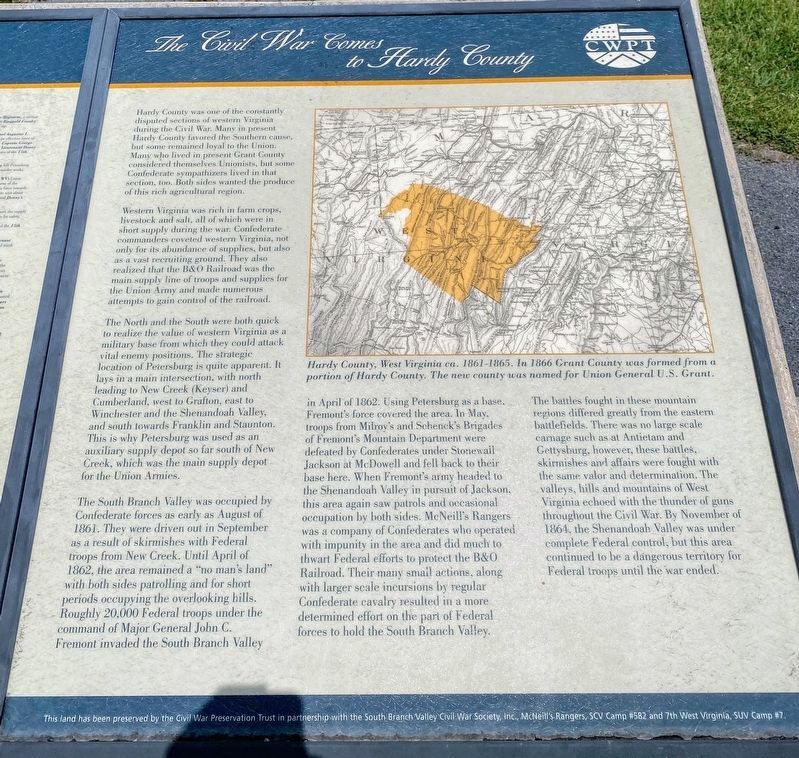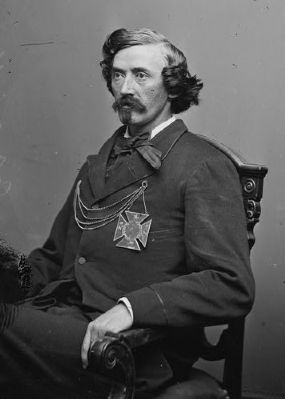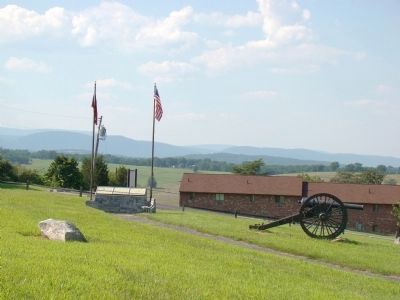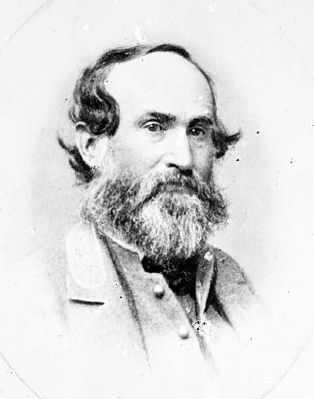Petersburg in Grant County, West Virginia — The American South (Appalachia)
The Irish Brigade & the McNeill Rangers / The Civil War Comes to Hardy County
Military Events near Petersburg, WV
Inscription.
The Irish Brigade & the McNeill Rangers
General James A. Mulligan, USA Born June 25, 1830 in Utica, NY, James Adelbert Mulligan was a spirited Irish-American who wore a green scarf in combat. At the outbreak of the Civil War he recruited, and was made Colonel of the 23rd Illinois Volunteer Infantry, known as the Irish Brigade. He served with great gallantry, first in the West and later in the East, being twice captured and severely wounded.
After his surrender and exchange at the siege of Lexington Missouri, Mulligan was eventually sent east under the command of Brigadier General Benjamin F. Kelley. For roughly a year he was sent on various missions in Western Virginia, wherever he was most needed. In the summer of 1863, Kelley sent 33-year-old Colonel Mulligan and his Irish Brigade up from New Creek (Keyser). His mission was to fortify and hold a position at Petersburg, located at a vital point along Lincoln’s “snakelike” border between the North and the South. On the highest hill in the immediate area, Mulligan constructed what appeared to be an impregnable fortress.
Colonel Mulligan commanded the garrison here at Petersburg during the summer and fall of 1863, having at one time 68 officers, 1532 men and 7 pieces of field artillery. Mulligan left Petersburg in November to return to New Creek. He was replaced by Colonel Joseph Thoburn who took command of the fort.
Sent east to Winchester, Mulligan was wounded while leading a charge at the battle of Kernstown on July 24, 1864. While being carried off the field he noticed that the colors of his brigade were endangered. “Lay me down and save the flag,” he ordered. His men hesitated, but finally obeyed. Before they returned, he had been bourn away by the enemy and died a prisoner in Winchester, Virginia on July 26, 1864. Mulligan had been breveted a Brigadier General of Volunteers just a few weeks earlier.
Captain John H. McNeill, CSA John Hanson McNeill was born June 12, 1815, a short distance from Moorefield. In April of 1861, he was commissioned by Missouri Governor Jackson to raise a company of militia and join General Price. Twice commended for bravery, McNeill was wounded at Lexington and later captured, along with his son Jesse. After a daring escape from prison, McNeill and his son returned to Hardy County and once again took up the cause of the Confederacy.
Captain McNeill’s company of 1st Virginia Partisan Rangers was accepted into Confederate service on September 24, 1862. It was merged into the 18th Virginia Cavalry, and then part of McNeill’s command was reassigned in February of 1863. The other section remained under McNeill’s personal command. Few groups were more effective than the some 210 men of the McNeill Rangers. Hardy County served as their main base of operations. The McNeill Rangers were considered “bushwhackers” by many Union generals as they pursued their objectives—creating general havoc among the Federal troops, disrupting traffic and communications on the B&O Railroad, and foraging for beef cattle to supply the Confederate armies.
On October 3, 1863, having learned of a wagon train bringing supplies to Union troops around Harrisonburg, the McNeill Rangers attacked a force of Federals guarding the bridge over the Shenandoah. They captured the bridge and some 60 Union prisoners, but in the confusion McNeill was mortally wounded. He was taken to the home of a Methodist minister where, knowing they were in danger of capture, he said “Goodbye, my boys, leave me to my fate. I can do no more for my country.” He was later smuggled to Harrisonburg where he died November 10, 1864. The McNeill Rangers continued under the leadership of his son Jesse, who never forgot what his father taught him—in leading a raid, one should always look well for a getting-out-place before going in.
“we will fight to the last crust or cartridge” —Mulligan’s Men, April 1863
Military Events near Petersburg, WV
June 2, 1861 – The South Branch Riflemen, a Confederate company organized in Hardy and Pendleton counties and commanded by Captain John H. Everly, was ordered to Harpers Ferry. At Burlington the company learned that Federal forces controlled the B&O Railroad. They returned to Williamsport and set up camp awaiting further orders. The Riflemen were designated Company B of the 33rd Virginia Infantry. Many of the men from this company were recruited from what is now Grant County. After the battle and surrender at Rich Mountain in July 1861, many members joined McNeill’s Rangers and the 11th Virginia Cavalry.
July 14–15, 1861 – After burning the bridge at Stoney River, on the Northwest Pike, nearly 1,000 Confederate troops were encamped a short distance east of Greenland. The Confederates learned of the approach of Union forces and retreated on July 15th for Petersburg. Union Colonel Thomas Marton and the 30th Ohio Infantry were forced to send his artillery and wagons on a seven mile detour over the Northwestern turnpike after Confederates destroyed the bridge over Peterson’s Creek.
July 16, 1861 – Remnants of General Robert S. Garnett’s Confederate soldiers were encamped at Petersburg for three days after retreating from Carricks Ford.
July 17, 1861 – Brigadier General Charles Hill’s Union forces of 4,600 soldiers came within five miles of Petersburg while pursuing Garnett’s retreating forces. The pursuit was discontinued per orders of General George B. McClellan. The Federal failure to capture the Confederates ended McClellan’s northwestern Virginia campaign. On July 22, 1861, he was ordered to Washington to assume a higher command. The Union forces were now in control of Trans-Allegheny Virginia.
September 12, 1861 – (Battle of Petersburg, Western Virginia) A battle was fought at the old meeting house one mile north of town between the forces of Colonel Jackson’s Confederate soldiers, the 4th Ohio Infantry, and Captain John Key’s Ringgold Cavalry and one artillery piece. The Confederates retreated to Franklin and Moorefield.
December 3, 1861 – Union Company I, 7th West Virginia Infantry was mustered in at Greenland under Captain Daniel C. M. Schell.
May 9–11, 1862 – Union General Louis Blenker and his division of nearly 7,000 soldiers joined Fremont at Petersburg. The division of three brigades was commanded by Generals Bohlen and Stahel, and Colonel Steinwehr.
May 12, 1862 – Petersburg became Headquarters Army in the Field under Colonel and Assistant Adjutant General Albert Tracy. Fremont marched south to Franklin to assist General R. C. Schenck and General R. H. Milroy after the battle of McDowell. General Blenker’s division remained encamped in Petersburg.
May 25–27, 1862 – Union General Fremont left Franklin and marched north to Petersburg. A depot was set up in Petersburg, supplied by wagon trains from New Creek. Fremont’s forces marched eastwardly into Moorefield at nightfall on the 27th, with orders from President Lincoln to engage Confederate General Stonewall Jackson in the Shenandoah Valley.
June 22, 1862 – The Union garrison under Lieutenant Colonel Stephen W. Downey at Petersburg was warned by Brigadier General B. F. Kelley at Cumberland that the enemy under General Ewell was moving towards Petersburg with a force of 4,000 soldiers.
October 29, 1862 – Union Lieutenant Colonel James Quick of the 23rd Illinois took the cavalry of Companies A, C, D, and the Ringgold Cavalry and a section of Rourke’s battery from New Creek to intercept 400 of Confederate
General Stuart’s cavalry force at Seymoursville. Confederate General John D. Imboden and his force of 700 men were at that time encamped at Petersburg.
April 24, 1863 – (Jones-Imboden Raid) Confederate General William “Grumble” Jones with infantry, cavalry and artillery approached Petersburg. Infantry and artillery could not ford the South Branch of the Potomac River because of recent flooding. General Jones and his effective force of 2,500 cavalry forded the South Branch and proceeded around the 23rd Illinois Infantry stationed at Petersburg without their artillery and infantry.
April 25, 1863 – (Battle of Greenland Gap) Confederate General Jones’ cavalry forces attacked Captain Jacob Smith’s 14th West Virginia Volunteer Infantry and Captain Martin Wallace’s 23rd Illinois Co. G at Greenland Gap. The Federals took up positions in log buildings near the road. Several requests were made for the Union troops to surrender. Captains Wallace and Smith finally surrendered. The Confederate casualties were 6 killed and 35 wounded (3 died of wounds later). Union forces suffered 2 killed, 6 wounded and 85 captured.
Confederate cavalry reformed and moved westward through the gap. Confederate units were: 6th Virginia Cavalry – Lieutenant Colonel John S. Green; 7th Virginia Cavalry – Colonel Richard Dulaney; 11th Virginia Cavalry – Colonel Lunsford L Lomax; 12th Virginia Cavalry – Colonel Asher W. Harman; 18th Virginia Cavalry, Co. E Partisan Rangers – Captain John H. McNeill; 34th Virginia Cavalry – Lieutenant Colonel Elijah V. White; 1st Maryland Cavalry – Major Ridgely Brown.
May 4–5, 1863 – The following Union troops were encamped at Greenland Gap: 1st West Virginia Volunteer Infantry Co. G, 22nd Pennsylvania Cavalry, 126th Ohio Infantry, and 6th West Virginia Battery.
May 12, 1863 – The 1st West Virginia Volunteer Infantry Co. G began building a blockhouse at the west end of Greenland Gap.
September 4, 1863 – (Skirmish at Petersburg Gap) Union Major Edward W. Stephens, commanding a detachment of 1st West Virginia Infantry at Moorefield, was attacked by Confederate forces commanded by Major General Fitzhugh Lee. The 23rd Illinois Regiment was sent to Stephens’ aid from Fort Mulligan in Petersburg, but was held in check by men of McNeill’s Rangers at Petersburg Gap.
September 6, 1863 – Union Colonel Jacob Campbell and the 54th Pennsylvania Infantry and one company of the 10th West Virginia Infantry arrived in Petersburg, where they remained ten days.
September 11, 1863 – Union Major Edward W. Stephens with the companies of the 1st West Virginia Infantry and Captain Andres Barr’s company of cavalry left Petersburg towards Moorefield where they were attacked by Captain McNeill and his Confederate cavalry. The Union forces had 146 men of the command captured. Private Henry C. Slusher, of Barr’s company, later received the Medal of Honor on April 4, 1898. Slusher’s citation stated he voluntarily crossed a branch of the Potomac River under fire to rescue a wounded comrade held prisoner by the enemy. He was wounded and taken prisoner in the attempt.
November 16, 1863 – An 80 wagon supply train bound for Petersburg was attacked at Burlington by Confederate Captain McNeill and a detachment from the 62nd Virginia Regiment. The train was being escorted by the 14th West Virginia Infantry and the Potomac Home Guard. Five wagons were burned, 245 horses, and 43 Union teamsters captured.
December 8-9, 1863 – (Salem Raid) Union Brigadier General W. W. Averell’s brigade left New Creek and arrived in Petersburg with three regiments of cavalry and a battery. The four mile long column was ordered to destroy the Virginia and Tennessee Railroad and supply town of Salem, VA.
December 23, 1863 – Union Colonel Joseph Thoburn and the 1st and 14th West Virginia returned to Petersburg with Brigadier General Averell’s wagon train.
January 2, 1864 – Confederate Major General Fitzhugh Lee’s forces began a foraging expedition into the South Branch Valley. Lee decided to bypass the entrenchments at Petersburg, but ordered McNeill’s Rangers and Gilmor’s battalion to guard the Moorefield and Petersburgh road as his command moved towards the Federal supply base at New Creek. The Confederates captured a 40 wagon Federal supply train north of Moorefield loaded with raw been hides and artillery ammunition.
January 7, 1864 – The Confederate forces of Fitzhugh Lee’s and Rosser’s fell back from the valley at the South Branch towards General Early in the Shenandoah Valley. Their failure to take the garrison at Petersburg was due to their inability to move their artillery and supply wagons forward because of poor road conditions.
January 30, 1864 – (Skirmish at Medley) Eighty Union supply wagons en route for Fort Mulligan at Petersburg, escorted by Union Colonel Joseph Snider and the 4th West Virginia Cavalry, were attacked and all trains captured by the Confederate forces of Brigadier General Thomas Rosser.
January 31, 1864 – (Evacuation of Fort Mulligan) Union Colonel Joseph Thoburn and the soldiers at Fort Mulligan in Petersburg gathered their supplies and wagons and evacuated the fort. They retreated towards New Creek by the Ridge Road, Reels Gap and crossed a spur of the New Creek Mountain to the eastern base of the Allegheny Mountains and on towards the western end of Greenland Gap. At daylight of the 31st, Confederate General Jubal Early and his forces set up their artillery on Town Hill and opened fire on the fort. They shelled the fort for some time before discovering that the works were unoccupied.
February 1, 1864 – Confederate General Early’s 35th, 45th, and 49th Georgia Infantry Regiments left Petersburg and marched towards Moorefield with 51 wagons captured by Brigadier General Thomas Rosser’s Cavalry Brigade. The Georgians destroyed the Federal bombproofs and winter quarters at Fort Mulligan.
February 6, 1864 – Union Colonel Mulligan ordered the 23rd Illinois Regiment at Greenland Gap to scout strongly towards Petersburg and Moorefield to keep McNeill’s Rangers in check.
February 7, 1864 – Union Colonel Mulligan requested permission to permanently occupy Greenland Gap, for the protection of the New Creek Mountain Range into Petersburg and Moorefield.
February 21, 1864 – The 23rd Illinois Regiment a section of Carlin’s battery and two companies of Ringgold Cavalry battalion permanently occupied Greenland Gap.
March 1, 1864 – Union Lieutenant Colonel Augustus J. Root and the 15th New York Cavalry with an effective force of 400 arrived in Petersburg and were encamped. Captain George T. Work and 13 of the Ringgold Cavalry and Lieutenant Denny and 23 of his men arrived to guard the supply train of the 15th New York Cavalry.
March 2, 1864. – The 15th New York Cavalry left Parkersburg towards Franklin and destroyed the saltpeter and powder works.
March 3, 1864 – (Skirmish near Petersburg, WV) Union Captain George T. Work, commanding a detachment of the Ringgold Cavalry, sent Lieutenant Denny and his force towards Moorefield. Denny came in contact with a Confederate unit about five miles from Petersburg. A sharp skirmish ensued and Denny’s troops retreated back to Petersburg.
March 4, 1864 – Union Captain Work decided to move the supply trains of the 15th New York Cavalry to Greenland Gap for safety.
March 5, 1864 – Union Lieutenant Colonel Root and the 15th New York Cavalry returned to Petersburg.
March 6, 1864 – With no supply wagons on hand, Lieutenant Colonel Root and the 15th New York Cavalry returned to Petersburg.
May 1964– The 2nd Maryland Potomac Home Brigade Infantry began construction of the earthworks that command the approaches to Greenland Gap via Petersburg Road and Allegheny Pike. Several scouts were also made by detachments of the regiment to Petersburg in search of Imboden and McNeil.
June 19, 1864 – (Skirmish at Johnsons Run) Union Captain John Boggs and 30 men of the Pendleton Home Guard, garrisoned at Petersburg, were attacked on Johnsons Run by McNeil’s Rangers under the command of Confederate Lieutenant H. J. Dolan. Dolan was mortally wounded leading the charge.
June 20, 1864 – McNeill’s Rangers, seeking retaliation against the Union Home Guard for the death of Confederate Lieutenant Dolan, invaded the Pro-Union Smoke Hole community killing several Home Guards before withdrawing to Moorefield.
June 20, 1864 – Union General B. F. Kelley ordered a detachment of the 154th Ohio Volunteer Infantry from Greenland Gap to a point halfway between Moorefield and Petersburg to intercept McNeill’s captured wagon train of supplies.
July 1, 1864 – Brigadier General B. F. Kelley ordered Colonel Robert Stevenson at Greenland Gap to send 200 infantry on a scouting mission. The detachment traversed a high mountain known as Charlie’s Knob. The Federal troops found a Rebel signal station. From the top, Petersburg and Moorefield could be viewed. There was no sign of McNeill’s Confederate forces.
January 11–15, 1865 – Union Major Elias S. Troxel and 200 men of the 22nd Pennsylvania Cavalry left New Creek via Greenland Gap to Petersburg. They found about 100 men of McNeill’s and Woodson’s Confederate command on the opposite side of the rain-swollen river. The Federal cavalry moved up the North Fork and arrived at the Mouth of Seneca on the 13th. Captain Boggs, of the Home Guards, and 40 men joined Troxel for an attack on the Confederates at Franklin. The Rebels learned of the impending attack and fled to the mountains. The Union troops retraced their steps back to Petersburg and encountered McNeill’s command who fired on them from the mountain sides.
The Civil War Comes to Hardy County
Hardy County was one of the constantly disputed sections of western Virginia during the Civil War. Many in present Hardy County favored the Southern cause, but some remained loyal to the Union. Many who lived in present Grant County considered themselves Unionists, but some Confederate sympathizers lived in that section, too. Both sides wanted the produce of this rich agricultural region.
Western Virginia was rich in farm crops, livestock and salt, all of which were in short supply during the war. Confederate commanders coveted western Virginia, not only for its abundance of supplies, but also as a vast recruiting ground. They also realized that the B&O Railroad was the main supply line of troops and supplies for the Union Army and made numerous attempts to gain control of the railroad.
The North and the South were both quick to realize the value of western Virginia as a military base from which they could attack vital enemy positions. The strategic location of Petersburg is quite apparent. It lays in a main intersection, with north leading to New Creek (Keyser) and Cumberland, west to Grafton, east to Winchester and the Shenandoah Valley, and south towards Franklin and Staunton. This is why Petersburg was used as an auxiliary supply depot so far south of New Creek, which was the main supply depot for the Union Armies.
The South Branch Valley was occupied by Confederate forces as early as August of 1861. They were driven out in September as a result of skirmishes with Federal troops from New Creek. Until April of 1862, the area remained a “no man’s land” with both sides patrolling and for short period occupying the overlooking hills. Roughly 20,000 Federal troops under the command of Major General John C. Fremont invaded the South Branch Valley in April of 1862. Using Petersburg as a base Fremont covered the area. In May, troops from Milroy’s and Schenck’s Brigades of Fremont’s Mountain Department were defeated by Confederates under Stonewall Jackson at McDowell and fell back to their base here. When Fremont’s army headed to the Shenandoah Valley in pursuit of Jackson, this area again saw patrols and occasional occupation by both sides. McNeill’s Rangers was a company of Confederates who operated with impunity in the area and did much to thwart Federal efforts to protect the B&O Railroad. Their many small actions, along with larger scale incursions by regular Confederate cavalry resulted in a more determined effort on the part of Federal forces to hold the South Branch Valley.
The battles fought in these mountain regions differed greatly from the eastern battlefields. There was no large-scale carnage such as at Antietam and Gettysburg; however, these battles, skirmishes and affairs were fought with the same valor and determination. The valleys, hills and mountains of West Virginia echoed with the thunder of guns throughout the Civil War. By November of 1864, the Shenandoah Valley was under complete Federal control, but this area continued to be dangerous territory for Federal troops until the war ended.
Erected by Civil War Preservation Trust.
Topics and series. This historical marker is listed in this topic list: War, US Civil. In addition, it is included in the Former U.S. Presidents: #16 Abraham Lincoln series list. A significant historical month for this entry is January 1980.
Location. 39° 0.082′ N, 79° 8.343′ W. Marker is in Petersburg, West Virginia, in Grant County. Marker can be reached from Grant Memorial Hospital Parking Lot south of West Virginia Route 55. Touch for map. Marker is in this post office area: Petersburg WV 26847, United States of America. Touch for directions.
Other nearby markers. At least 8 other markers are within walking distance of this marker. Welcome to Fort Mulligan Civil War Site (a few steps from this marker); Parrott Rifle (within shouting distance of this marker); The Last Days of Fort Mulligan (within shouting distance of this marker); Civil War Cannons (within shouting distance of this marker); Protecting Supplies (about 300 feet away, measured in a direct line); Defending the Fort (about 400 feet away); A Strategic Location (about 400 feet away); The Impregnable Fortress (about 500 feet away). Touch for a list and map of all markers in Petersburg.
More about this marker. This three-panel marker is on a stone pedestal at the flagpoles just off the parking lot. In addition to the illustrations reproduced as closeups on this page, there is a reproduction on the left-most panel of a recruitment handbill entitled “Mulligan’s Brigade” offering a “$402 Bounty!” to veterans and “$302 to all other volunteers”. This panel also shows a three line newspaper headline dated Saturday, July 30, 1864, that reads “Death of Colonel Mulligan. The Hero of Lexington Fallen — Life and Character of the Deceased — Services in the Field — Preparation for the Funeral”.
Additional commentary.
1. Clash at Greenland Gap, April 25, 1863
For more information and map about the sharp little battle at Greenland Gap on April 25, 1863, please consider reading the article entitled, "To the Last Crust and Cartridge" - in Civil War Times Magazine, January 2007, pgs. 46-52, by George Skoch.
— Submitted August 28, 2009, by George Skoch of Fairview Park, Ohio.
Credits. This page was last revised on February 1, 2024. It was originally submitted on December 27, 2008. This page has been viewed 7,377 times since then and 129 times this year. Last updated on January 30, 2024. Photos: 1. submitted on December 27, 2008, by J. J. Prats of Powell, Ohio. 2, 3, 4. submitted on May 12, 2021, by Shane Oliver of Richmond, Virginia. 5, 6, 7. submitted on December 27, 2008, by J. J. Prats of Powell, Ohio. • Bernard Fisher was the editor who published this page.
